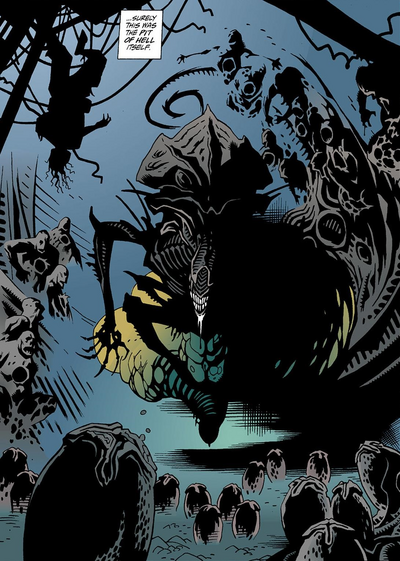It has always been in their nature to be parasites. From birth, it's what they do. We shouldn't be surprised that it applied to their own kind as well.

The Xenomorph species is often compared to the hive/social structure of Terran social insects. This analogy seems to be apt, as a recently documented phenomenon within the Weyland-Yutani scientific community studying the creatures has documented a behavior for some colonies that is reminiscent of Brood Parasitism
Parasite Queens are a specialized breed of Xenomorph Queen that usurps the broods of other Queens, emanating a pacifying agent that lulls the enemy drones into compliance.
Biology[]
The Parasite Queen has a similar biology to that of a regular Xenomorph Queen, with the exception that it is capable of emitting a field of spores that pacify other Xenomorph specimen, regardless of their genetic origin or loyalty to their own Hives.
Parasite Queens fortunately do not have the ability to birth as many Facehuggers as an average Queen specimen, so it instinctually seeks out the nest of another Queen, quickly turning its children against it, and usurping the colony as its new Queen. The Hive's old workers are simply worked to death as the Parasite Queen's spawn prosper.
Parasite Queens are especially feared for their ability to potentially subvert every Xenomorph on a planet, and potentially even other Queens.
Parasite Hives[]
The Parasite Queen begins its life cycle by infiltrating the nest of a normal Xenomorph Queen. The Parasite Queen emits a unique form of spore known as Xenomycete (similar in some ways to terran Cordyceps Fungus), that renders other Xenomorphs docile. Parasite Queens and their progeny are naturally immune to the mold, which burrows into the neural matter of the victim nest's drones, and after the Parasite Queen leads the nest in murderous rebellion against the original Queen, the Parasite will take her position and begin spawning young. Eventually, the quantity of Parasite Drones will overwhelm the normal population (still being puppeteered by the Parasite Spores), and the Parasites will begin to aggressively devour all resources in the area.
It is currently unknown if Parasite Queens and their broods are a specific subspecies of Xenomorphs, or indeed if they are some form of natural behavior Queens take on to reduce overpopulation in Xenomorph communities.
Unique Strains[]
All Parasite Xenomorphs are identical to normal Xenomorphs, with the exception of their continuous production of the Xenomycete. The following are some unique strains associated with the Parasite Queens.
- Xenomycete: A bizarre, alien fungus that is emitted from Parasite Xenomorph respiration. The fungus is harmless to uninfected humans, but will take root in Xenomorph brain matter, rendering them docile and subservient to the intruders. As the infection devours the host, the Xenomorphs begin to rot from the inside out, and can turn visibly green as the mold feeds on them for nutrients. Humans who are infected with Chestbursters who have the misfortune of coming in contact with the mold suffer a violent and fatal consequence as it devours the alien within them, and any surrounding tissue that was altered by the Chestburster's Enzymes.
- Stalker: A large, arachnoid Xenomorph with eight legs, each tipped with flexible claws. Stalkers are extremely fast and stealthy, and seem to be hatched from other Xenomorphs that have been infected with the Xenomycete.
Natural Behavior or Something Else?[]
There is speculation in some Xenobiology communities that Brood Parasitism is not a natural behavior of the Xenomorph at all, rather that the strain is an artificial one, adapted to symbiotically produce and utilize the Xenomycete mold. This theory suggests that rather than the mold being produced naturally by the Parasite Xenomorphs, it was an outside vector that infected a hive of Xenomorphs, who would go on to spread the aberrant Parasite Breed.